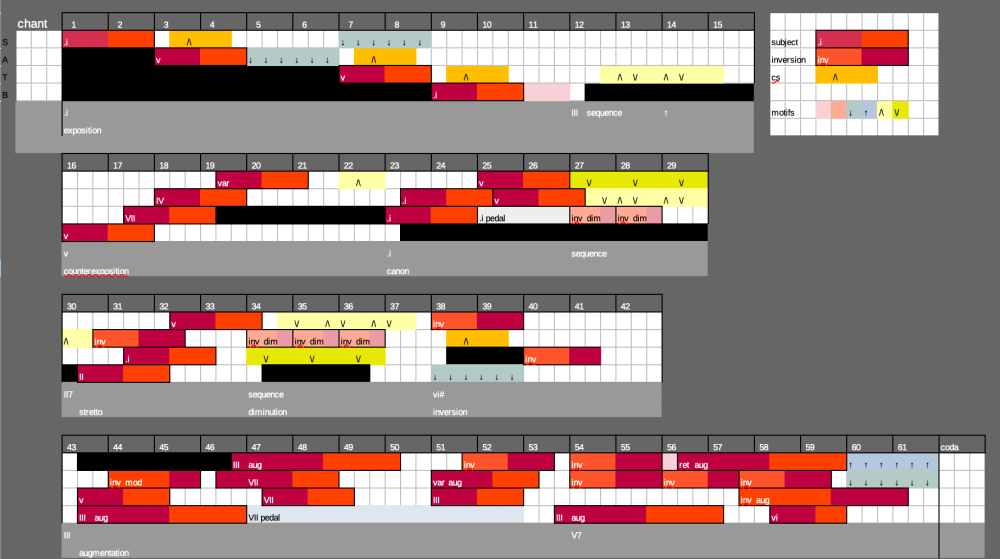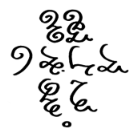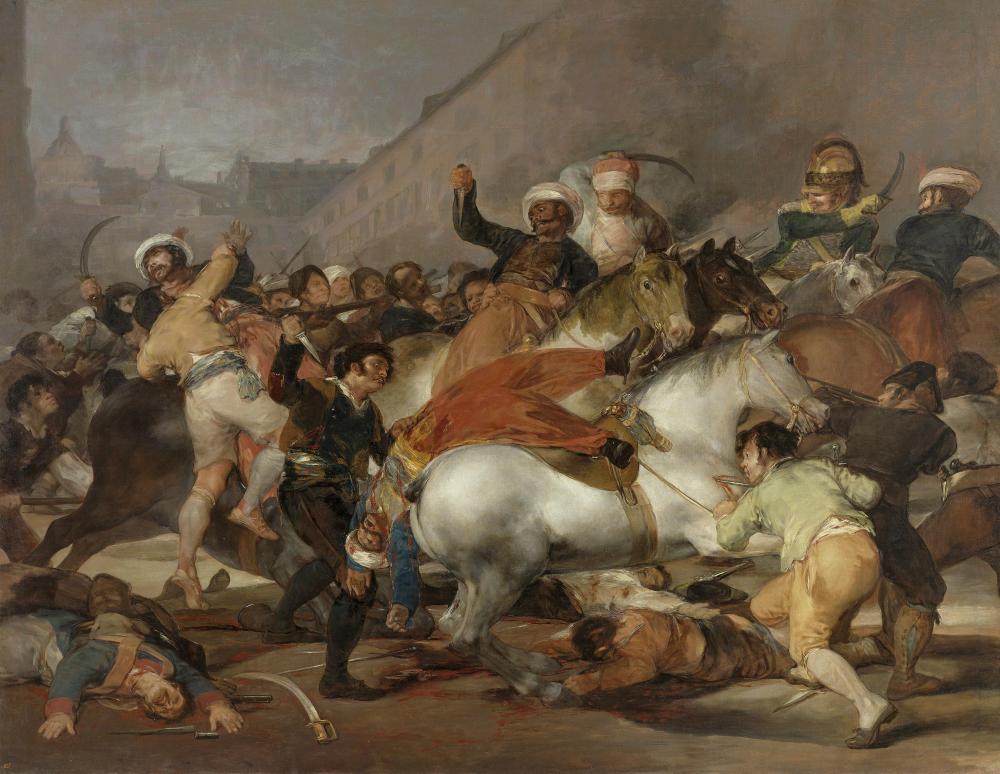Search the Community
Showing results for tags 'fugue'.
-
This is the final draft of my best work up to date in my life, String Sextet in G flat major. Posts of seperate movements have been posted before and I'm not gonna repeat it here. If you're interested in the music details, pls check the following YCs: 1st Mov: 2nd mov: Here is the score and YT link of the work: String Sextet in G flat major.pdf Here is the structure of the work: (*denotes parts I love). The two movement structure is inspired by Mahler's 8th Symphony, so the second movement is proportionally much longer than 1st movement: 0:00 Opening credit and structure 0:11 1st Mov, 1st Part: Tao Primo (*3:35-3:47 nice bridge, **4:40-5:26 nice chromatics) 5:34 1st Mov, 2nd Part: Minore, a fugato, some little challenges (**9:40-10:10 nice retransition) 10:10 1st Mov, 3rd Part: Tao Return, a triple fugue and ending (falsely) (*11:45, **12:46 till the end) 14:48 2nd Mov, Lamentoso: Denial of Tao and realization of the realistic World full of tragedies. (*16:54, *19:11, ***19:44 sounds like my version of Bee's op.131 finale!, ***23:38-25:15 most emotional passage for me) 26:33 2nd Mov, Fugue a6: Objectification of emotions and reason. The most difficult passage for me to write technically but easiest emotionally. (**28:10-28:42 includes a 6 part stretto of 1st subject and a nice C minor modultation quoting my own Clarinet Quintet, ****30:07-31:27 a 6 part stretto of 2nd subject and one of my fav. section in the entire work with the very beautiful C minor passage, ***32:58-34:31 nice turn to pentatonics and nice disappointment) 35:03 2nd Mov, The Return. Start picking up the real self and soul and connect oneself with Tao, finding self equals to finding Tao. “I Six Books explain me and I explain Six Books (Lu Jiuyuan)”(*35:03-35:36 try to regain energy, **37:05,37:37,38:11,38:43 Nice color, **39:12 nice folk melody, ***39:15-40:15 Nice pizz.! And a very nice snap pizz! **** 40:46-41:46This passage leaves me in wonder. I don't know how do I compose this, **42:17-43:23 Nice appetizer fugato, ****43:24-44:53 Grand Climax!, ***44:54-45:41 Nice heterophonic passage which ignites my creative power for this movement, *****45:42 till end Pefect ending) This work was first inspired by Chinese Philosopher Tang Chun I's Realm of Heavenly Morality in his monumental book, The Existence of Life and the World of Spirituality, in April 2022. I wanna felt and descibed it hence I finished the whole 1st mov. I thought it's enough, until I met with my dedicatee Johnson, my respected philosophy professor Dr. Tao and my friend Merina in April 2023, and I knew it's not enough since without pain Tao isn't possible at all. After some painful incidents in 2024, I am finally able to finish the whole piece in March 2025. For me this work is about Tao, Tao lost and Tao regained. Since this would be the final post on the Sextet, please let me acknowledge people I would like to thank along my way of composing. This work is dedicated to and in memoriam Mr. Johnson Ho https://youtube.com/@beingintheworld?si=9Ch3hnk1UtluHTRF who sadly passed away in July 2024, and it's a regret the work couldn't be finished when he's alive. I would like to thank him for his great inspiration especially his postive way to deal with his illness. I would like to thank Dr. Tao, without his teaching esp. the one on the book Buddha-nature and Prajñā (?) did I realise the importance of pain and human suffering to morality and humanity, and probably won't have enough philosophical basis for this work. I would like to thank Mr. Vince Meyer @Thatguy v2.0, who acts as my musical Virgil, providing so many inspiration particularly in this piece's fugue and different motivic usage, and also make this great recording. Also, thank him for his encouragement when I kept saying I could never finish this piece. I would like to thank Dr. David Goza http://www.youtube.com/@David_Goza ,without his videos on YT I would never able to improve my own writing. I would like to thank Merina, Yvonne, Arjuna @expert21 and Peter @PeterthePapercomPoser for staying with me in my difficult times. I would like to thank Mike @chopin for his idea to go back to medieval texture in the Return. I would like to thank Luis @Luis Hernández which helps me solve the harmonic progression btw tritiones. I would also like to thank my ex-boss's mistreatment, as she teaches me a great lesson and the pain helps me reflect a lot which shows here. Also, thanks to everyone who has listen to this piece before and comments, as they help me a lot. Thank you Young Composers Forum and @chopin for giving me a chance to grow musically. Thank you for everyone who has commented on the work's parts before, I especially love the comments by @Fugax Contrapunctus @Giacomo925. Last but most importantly, I would like to thank my mum and family. Without their love I would probably fall much deeper and won't be able to finish this piece at all. Thank you!! P.S. One interesting fact on the piece is that it stays longer in F sharp minor then G flat Major….. Henry
-
I wrote this for fun and exercise. Thank you.
-
This is intended to be the second part of the second movement of my String Sextet in G flat major, after the part of Lamentoso. These two parts are very different from the more fleeing and transcendental first movement as I hope they capture the sadness of the time and what I feel, before leaping back to the world of the pentatonics later, which would make the pentatonics more grounded. Here is the first movement of the piece: Here is the first part of the second movement of the piece, the Lamentoso, which is actually finished after this fugue: Here are the scores, the original version and a version with my own (painful) analysis on it: Final Fugue from String Sextet movement 2.pdf(With Analysis) Final Fugue from String Sextet movement 2.pdf And here is the youtube video: The piece is dedicated to Mr. Johnson Ho. The finishing of the fugue is prompted by hearing his worsening health, so I really want him to stay healthy. The inspiration of the fugue first comes from my friend Mike @chopin and my mentor David (I am very honoured to name him my mentor even though we have never met in real life since his videos form the skeleton of my composing skill. Go watch his analysis videos NOW!) said that the middle fugato section from the first movement is the best part of the movement. I was shocked since I believed it was the worst of the movement! Then my bro Vince @Thatguy v2.0 (who also makes this perfect audio) inspired me to write a dense fugue for the second movement, and so I challenged myself to write a six part fugue, since I feel like it’s not fully realised in the first movement. This is he most difficult I have ever written, but finishing it I now consider it my most beautiful work composed up to date. It’s so emotionally deep, even weirdly I feel zero emotion during the composition process, only calculating the counterpoint haha. I am so satisfied with the result. The fugue comprises of three subjects, all from the 1st movement. The 1st and 2nd subjects are from the 1st movement fugue’s subject, while the 3rd subject is derived from the opening theme of the Sextet’s first movement. Here is the plan of the movement (time according to youtube video): First part (00:03): First subject enters in each instruments, inversion introduced at . All of sudden C minor enters (01:55) and I quote my subject of the C minor Clarinet Quintet 3rd movement fugue here to intensify the sadness. Also kind of replying to the relationship of G flat major and C major in the first movement, but while freedom is shared there, now sadness is shared. Second Part (02:12): Second subject enters and the section features a saturation of stretti. The C minor section (03:56) comes in at and it’s my favourite section of the whole fugue. It’s insanely tragically beautiful here. Third Part: Third subject enters (04:58), first and second subjects combine in the manner of the 1st movement fugato. The intensity is kind of lowered after that insanely tragic C minor section, maybe kind of accepting and reflecting upon it, and it’s less saturated with the subjects. However things starting to get intensified, first the third subject is treated as in Bach’s Chorale Preludes when it is cut up and divided to four phrases alongside the other two subjects (06:29). The only pentatonic entry (07:16) arrives to kind of relate itself to the first movement and hints what will come at the end, but at the meantime it’s defeated by disappointment and the fugue ends in a doubtful manner, which will lead to the chant section. Hopefully I would finish the whole movement as soon as possible! Hope you enjoy the fugue now! Henry
-
So this is the final draft of the entire 2nd movement of my String Sextet. I can confidently say this is my best movement of music ever written up to date. The movement is divided into three parts: Lamentoso, Fugue a6 and the Return. The first two parts of the movements have been posted before in below links: Lamentoso: Fugue a6: If you want to skip to the newest content I compose, you may skip to 20:16. The musical analysis of the Lamentoso and Fugue have already been done in the link posted above so I won’t repeat it here. Here is the YT link and score of the movement: (Final Draft) String Sextet 2nd mov with last page.pdf Here is the YC post to the first mov of the same Sextet: Here is the structure of the movement: 00:00 Lamentoso The Eden in the 1st mov is great but man, come on and live in the real world. All sorts of tragedies happening and what ground do you have to claim the transcendence? I especially love the outburst in 4:59 and the passage starts from 8:53. 11:47 Fugue a6. This part is totally inspired by Vince’s @Thatguy v2.0 comment on my first movement “to write a dense fugue”, also to further explore the fugato in the 1st mov. Like @Giacomo925 said, this part summarises the sadness of the first 20 minutes of the movement. It always leaves me in awe that my favorite C minor passage, the absolute climax of the whole piece, lies in minute 30 exactly. The fugue aims to end on desperate terms but I won’t allow it. I try to give it a fight by recalling the pentatonic ideal even though in the wrong key of the tritone C major as hinted in the pentatonic section of the fugue, but the power is diminished. I need some purification for the paradise regained. Thx to @Luis Hernándezfor introducing me to tritone substitution in this part. The chant (22:01) begins with self murmuring of viola, occasionally inviting mysticism recalling 7:55 in Lamentoso and sadness of the 1st subject of the fugue. Two violas play together with the texture of a parallel organum. After a sad cry some more primitive power comes in to recall the passion and good of human beings, the theme is from b.27 of 1st mov. It gets agitated and experiences an epiphany in the form of Bartok Pizz. Both the chant and the folk melody is built around the 025 set! And the 025 set is the essence of the pentatonic scale! Furthermore a quartal chord is the further essence of 025 set, and hence the core of the whole pentatonic scale! Discovering this, the fury cannot be stopped. It leaves me in wonder how on earth can I write this thing out. After returning to the tonic key in 27:00, I decided to conceive it as a one off climax with build up. The idea is inspired by my playing of Beethoven’s op.110 when he did the same thing in the last movement as well. There is no “development” but only realisation of Tao in this imperfect world. There are appetizers to the ultra climax, first introducing the two most important themes sparingly, then in 27:16 theme in b.35 of 1st mov which is in fact inspired by my own Clarinet Quintet in C minor, and then an appetizer fugato responding to the lament in b.148 of the Lamentoso which is based on the opening theme. The entrée of Ultra Climax appears in 28:38, first is the first theme in tonic by first violin, viola, and cello, then second theme in C major by second violin, viola and cello. The playing of tritone is to prove Tao‘s omnipotence, also respond to the first mov and the fugue with the F# and C minor relationship. Using all 3 instruments for me is the resonance of Heaven, Earth and Human when they finally sing together the Tao they shared. I think I really feel the Chinese philosopher Tang Chun-i’s Realm of Heavenly Morality here. The modulation to Ab major, responding to b. 294 and 644 of 1st mov, complete what’s left undone there and finally Gb major is in triumph. A pedal point on a tritone is funny for me. The cello overlapping the violin is signifying earth and heaven interaction which is considered auspicious in Chinese classics I-ching. I am always in awe of the power exhibited here and wonder who’s actually the composer of this passage. The next passage in 30:07 is the heterophonic version of the 1st theme, which is where I was inspired miraculously by a Chinese music group. Next is the in extremis passage in 30:57. It’s the immanent version of the 1st theme. I was imagining what my friend’s thinking on his last day of life. The texture is probably inspired by the film music in Kurosawa’s Ikiru when the main character was swinging on the park’s swing to await his death. I quote Bach’s St. John Passion here for my friend’s name, and I find out that the lyrics fit too. I wish him to rest in peace and return to Tao. The final ending is probably inspired by the ending of Chopin’s Fantasie in F minor. I can never believe I would end the whole thing this positive in an absolute way. The whole passage always leaves me in tears. After writing the Lamentoso in May 2024 I had no power and inspiration at all to write anything in the Sextet since I was suffering in my full time job. I started picking up by working on the C# minor Piano Sonata first. After finishing that in Jan 2025 I felt like my negative power was expressed out, leaving the goods for this Sextet. I then went for a walk on 10 Feb 2025 and had a miracle, inspired by a Chinese music group, which turned on my creative power and I fervently completed the entire thing in just 18 days, when I had zero notes written in the past 9 months. It’s such a miracle I could have finished this piece this quick and good. My dedicatee Mr. Johnson Ho had already passed away last year. It's a shame that this piece couldn’t be completed when he’s alive, but I would be forever thankful for his inspiration. Special thanks must have been granted to my great friend Mr. Vince Meyer @Thatguy v2.0 for making this perfect audio and many ideas, and being a great friend, but I will leave it to the final version of the whole Sextet. Also a very special thanks must be given to my ex-boss. Thanks to her mistreatment, I have the pain to reflect on my own, the drive to finish the whole Sextet in a fury and the time to complete it when I was forced to resign for my own mental health. Foremost of course I must thank my dearest mum. But lol, the whole acknowledgement will be left to the post of the final version of the whole Sextet, including the first movement and this movement. This is a very long movement and commentary and I don’t expect anyone to listen and read till the end. But if you do so, here is my deepest gratitude to you. Feel free to comment as well, I would be very thankful to have received them. Thank you!!!!! Henry
-
A four-part tonal fugue in the instrumental style, composed upon a given subject. I made the first drafts about 12 years ago when I was still in university, but I hadn't worked on them until yesterday. I have mixed feelings about the result. (The slurs, as usual in my own counterpoint exercises, are meant to indicate various phrases and motifs and should not be taken as articulation.)
-
-
This is a revised version of an old fugue that I uploaded last June. It did not get much attention back then, so I hope for feedback regarding the relatively strange counterpoint, especially in the last page.
-
Hello Everyone! I'm Emile, I'm 18 years old and I'm from a little island called Aruba in the Caribbean. I'm really passionate about Music, I'm a Classical/Romantic Composer/Pianist and started to compose when I was 12 and started with the piano at 14(able to play late Beethoven sonatas). And I've started to try my best to be known out there currently working on a piano concerto in f minor, string quartets and I'm looking forward to meeting all of you and getting involved in the great things happening here on this forun. This is the 12 variations on a theme in C major. But this is the 11th Variation! this is my first Toccata and First Fugue! this toccata took me several weeks and i was inspired by the intro of his Choral Fantasy when i first listened to it! and i decided to dedicate this to Beethoven because I finish the piece a day before his birthday. Dedicated to (Departed) Ludwig van Beethoven, Birthday of the Year 2023 P.S - The 3 voice fugue is not in strict form it's a wander/sonata form 12 Variations and Nocturne for Viola and Piano on a theme in C Major.mid
-
So... Seeing @PeterthePapercomPoser a.k.a PeterthePitifulcomPoser and @Thatguy v2.0a.k.a VincetheVeryVindictivebutnotValiant having their fight, I was enjoying my popcorn aside. But then I saw that Peter’s badge for this year Christmans event is so beautiful… it allured me to write my own Christmas music! This piece is really a joking fugue which uses Jingle Bell and Vince‘s “How the Shopper Stole Christmas” as the subjects to form a double fugue: (We all know Jingle Bell right...)(It’s great to escape from the pressure of the 6 voice fugue of the Sextet Second movement LoL….) I know Vince hates fugue, so I deliberately manipulate his theme with all sorts of fugal techniques to troll him muahahaha!!! I also include some quotations including my own throughout the piece haha. I dedicate the piece to him since I have trolled him haha! However, the more I compose this one it appears to me less of a joke… Joking Fugue on Jingle Bell and my Friend’s Theme Final.pdf Here's the structure of the piece: 00:02 Jingle Bell Section. Includes troll stretto, troll inversion and troll retrograde. Crushed by the Hammer at the end… And we need some help with the “festive mood”. 02:10 Shopper Section: Includes troll stretto, troll inversion and troll retrograde (the same LoL). The bell is repaired at 04:03 so the Jingle Bell theme returns to combine with the shopper theme but appears in minor. Some interesting polyrhythms happen there too, maybe Vince’s prelude style secretly invades. Tension building (but still have time to quote my own work LoL) for the… 05:28 Overly-Triumphant return of the theme which quotes the texture of the Emperor Concerto, another counterpoint of both themes and ends in a learned way LoL! Thx to Vince for this perfect audio! I think there are no tears here this time @chopin and no random pauses anymore I think. Hope you all enjoy this one and Christmas! Henry
-
Fugue_In_F_Major__No._1__-_Aw_Ke_Shen.pdfI know its kinda weird/too late to ask since i have published it but... Do y'all consider this to be a fugue or a canon...or even something else? I am quite confused because of the varied array AND definitions of fugue and canon. The melody in the right hand is followed exactly in the left hand just one bar after for all parts. It is just that for some parts, the accompaniments /accompanying chords of the right hand are not present in the left hand for some parts as I want it to be that way - to have the chords retain their meanings and not make it sound too strong. So idk... This is one of my simplest pieces ( my 18th finalized and published piece ); I titled it " Fugue In F Major No. 1 ". Not sure if I should re-title it ( no point for the videoscore itself that has been published in my Instagram, TikTok and Youtube accounts ) at least in the parts that can be retitled - my Musescore and Souncloud accounts and the title ( though not videoscore ) in Instagram and Youtube. Nowadays I avoid deleting my posts just to re-upload them. Would be grateful if y'all can give feedback : ) Thanks : ) Video Score In YouTube: https://www.youtube.com/watch?v=yafHwhEacM4 Score In MuseScore: https://musescore.com/user/62605720/scores/13517182 The audio version is sped-up.
-
One day a couple of weeks ago, I found this post on /r/composer where some guy (/u/AHG1) wrote a fugue for organ when he was a teenager. Anyway, I thought the subject was interesting, so I decided to do the fugue my own way. The original composer supported my endeavors as well, so I'm happy that he can finally see what I've come up with. This isn't a particularly unique fugue in my opinion, but any and all comments are of course welcome regardless. https://drive.google.com/drive/u/0/folders/191AToucbt0E9Py-6MqM0y_22IHwqxq6R
-
Hi, I've been workin on this fugue, trying to apply my new knowledge. It's in G major, and there's controversy. In the subject the dominant note (D) appears quite clearly in measure 3. Is it supposed to be transposed tonally, i.e. a fourth up (G) instead of a fifth (A)? I didn't. As you can see in bar 8 it is as an A. It really is an ambiguous case "by the book". Since the D appears prominently but already in the third bar. So I tried to make the answer as you can see, and as it sounded good it stayed that way. The structure is: Exposition, where the 4 voices enter and the countersubject is written in invertible counterpoint. Divertimento, sequence or episode (measure 22) that modulates to the dominant (D). Counter-exposition (measure 26), using inverted subject and countersubject. Divertimento (m. 36) using Corelli's Leapfrog with the subject motive with other schemata and Cudworth cadence (which I like to use a lot). Stretti (m. 44) and mini-exposition with pedal note. Divertimento (m.58) in the subdominant area with plagal cadence and new Cudworth to return to the tonic. Coda (m 65) with perfect authentic cadence. As always happens to me, I'm sure I've missed parallels all over the place. But hey, someday I'll get closer....
-
The truth is that there are many, many topics that could be discussed about the leak, but in order not to be tiresome, this will be, for the time being at least, one last question that I would like to address. It is about invertible counterpoint, or double counterpoint. What is it? Well, that counterpoint in which the upper voice and the lower voice can be interchanged and still sound good. For this, it is necessary to make sure that the intervals (in strong beats) are consonant both in "normal" and "inverted" position. The most frequent is to see invertible counterpoint at the octave. That is, two lines that can be inverted by raising one an octave and lowering the other an octave. But you can also see invertible counterpoint at the twelfth (which is a fifth + octave). More rarely we will see the tenth (third + octave). And other intervals are not practical, or very rare. WHY IS THIS FUNDAMENTAL IN THE FUGUE? If we compose an invertible counter-subject with the subject, we gain two enormous advantages: 1) In following expositions or entries, we can safely change the order of the subject - countersubject voices. 2) This makes the fugue sound coherent and, for the sake of redundancy, makes it sound like a fugue. Because the fugue tries to reuse the initial material as much as possible. If anyone is interested, I can post my own appreciations of how to compose these counterpoints. The truth is that mastering the invertible to the octave, you have a long way to go. To illustrate this, I bring here a fantastic analysis of Bach's C minor fugue where there is not only one invertible counter-subject, but two. Thanks to that, during the development he is placing them up, down, in the middle..... With this technique you have a great part of the fugue done.
-
I wrote this for fun. Whenever I try to write fugues I don't have the patience to check all the intervals. Also, in this case, the tonalities sometimes get a little fuzzy. What I did was to start from a simple material Subject I and its counter-subject I, written in invertible counterpoint. Answer (subject II) and countersubject II, written in invertible counterpoint. In this way, these parts can work the same up and down or the other way around. And with this, I followed the following scheme:
- 4 replies
-
- 2
-

-
- invertible counterpoint
- organ
-
(and 1 more)
Tagged with:
-
One minutious revamp, two of Bach's favorite instruments, three dazzling voices - this piece has it all for me. The title is pretty much self-explainatory. Otherwise, please consider reading my YouTube video description here: Enjoy!
-
probably my most complicated work so far, and took me over a month.
-
Hi everyone! I wrote this baroque style fugue as a studie piece. I am applying to the Liszt Ferenc Academy of Music (in Budapest, Hungary) this year, and I want to send in this fugue (they require a lot of study piece). I am hoping some of you can help me out with ideas, how to make it more stylish, more accurate. I listened to it so many times, I can't really determine how "baroque" it is.
- 5 replies
-
- study piece
- baroque style
-
(and 1 more)
Tagged with:
-
Here I present two more fugues, also in a major&minor set. This time I tried to write for 4 voices in the major fugue, and I'm really satisfied with the result (tried 5 voices but quickly abandoned the idea). The minor fugue to me is less interesting but still has some things in the presentations of the subjects that was productive to compose. Hope you like them! Fuga_en_Fa_mayor.pdfFuga_en_Fa_Menor.pdf
-
This particular fugue, whose final version has been transposed one half step down from the original, has been the result of a rapid burst of creativity that often comes and goes in waves around this time of the year. Even though it was finished before midnight two days ago, the thought process of deciding on an extramusical title has taken a little longer than usual this time. In the end, I have dedicated this humble work of mine to the marvellous and everlasting art of Spanish painter Francisco de Goya, in commemoration of his famous oil on canvas "The charge of the Mamluks" which, as we know, depicts the insurrection of the people of Madrid against invading Napoleonic troops in May 2nd 1808, this exact date 215 years ago. The title itself, which roughly translates as "The unrelenting night train" is meant to evoke the profuse skirmishes that took place before the Puerta del Sol as the French colonial cavalry charged against the revolting crowds, thus igniting the first instance of bloodshed in what would come to be the Spanish War of Independence. Here's a royalty-free picture of this iconic painting among Goya's many masterpieces: Following the continued advice of some among my audiences, who suggested relieving the density of the counterpoint at certain points within my fugues, I have finally decided to try out this method, et voilà! I honestly can only say I could not possibly be happier with the result. How stubborn I was in keeping the full weight of the contrapuntal texture throughout the vast majority of my works in spite of my dear viewers' counsel! Thankfully, the wall encircling my mind has now been breached by these new perspectives, which I will henceforth apply to upcoming future fugues of mine. Enjoy!
- 4 replies
-
- 4
-

-
- fugue
- may 2nd 1808
-
(and 1 more)
Tagged with:
-
Last Thursday was a special date for the history of Western music. 337 years ago, on the 31st of March, a child was born in Eisenach, a town located in Thuringia, modern-day Germany. His name was Johann Sebastian Bach, and he would become one of the greatest composers ever to live, even though most of his fame would be posthumous. Regardless, it has been of the utmost pleasure for me to dedicate one of my humble fugues to the birthday of Master Bach, in order to commemorate his art and work of such unfathomable abundance and heavenly quality as his spirit deserves. Link to the video:
- 3 replies
-
- fugue
- counterpoint
-
(and 1 more)
Tagged with:
-
Hi I took a phrase from one of Bellini's first operas Adelson and Salvini, and wrote this. When making counterpoint or fugues I don't care anything but how it sounds for me. Including the weird modulation.
-
For the last couple evenings I have invested most of my energy into finishing this fugue, which as shown below the title is coupled with an aphorism in Spanish, my native language: "Cuando cae el respeto a la muerte, decae la vida misma", which, leaving aside metaphorical extension, would roughly translate into English as "When respect to death is lost, so degenerates life." Even though said aphorism wasn't the main inspiration for this piece, I thought it was a nifty addition given the fatigue and withering emotions it was intended to wake on the listener. Since it is difficult for me to describe the nuances of this one as strictly "enjoyable", I guess the most appropriate closing expression for this one would perhaps be "feel existential" or something on those lines.
-
Four fugues and 3 preludes (or whatever these can be called.) The counterpoint and style is mostly quite free, I took a lot of liberties with harmonies and voice leading if I thought it was interesting, so there's inevitably going to be parallel motion, but I think I'd rather take that than make it bland. It's been quite a long time since I've written this kind of music so it was really refreshing to go back to "my roots" and have fun with it. As for technical matters, the subjects for the fugues, save for the first one, are strange on purpose. Specially C minor and the second double fugue subject in the D minor fugue. I mean, they're workable, but I'm constantly harmonizing "against" the subjects, so this leads to some pretty fun moments like a subject that's supposed to be in G minor tonic being harmonized in Ebmajor, stuff like that. It was pretty challenging to get all of this done and stay somewhat inside the style of instrumental counterpoint that I like. The double fugue in D was hard to write and it went on for longer than I had anticipated, even after cutting all the fat. If there's something I realized when writing these things is that I have very little tolerance for sequencing that is there for the purpose of padding out the runtime of the piece. So I try to never sequence anything more than 3 times, and I will vary the amount between 3 and 2 depending on context. It's one of the trappings on the style and I understand better now a lot of composers that worked in this style post-baroque times, specially within the context of a sonata's development episode vs the way sequencing is used in a fugue. Combining both things is very difficult from both a conceptual and technical point of view. In fact, I grouped these fugues together (I wrote them in sequence within the span of 2 weeks or so) and in the end I feel this is also sort of, kind of, like a sonata. Even if there's no "sonata form" in these, but then, I get the feeling that the DNA of the thing is more leaning in that direction than something like Bach. I purposely avoided reusing countersubjects when I could help it, too, as to give myself more freedom to write whatever was more appropriate within the context of that moment, but that also has the unintended side effect that the whole thing feels a lot more complex than it really is (certainly felt that way when I was writing it.) I get the feeling that a lot of the typical baroque counterpoint conventions and traditions end up being shortcuts to pad out time, so I kind of didn't want to use them. If anything was too "automatic" I would cut it and rewrite, and I did this the entire time when writing. I have no idea if that's something audible, but well there you go. As for the score, it's not completed yet. All the music is there, but I need registration markings and a bunch of other things that I'm not going to write until meet up with the person who will be performing these, so we can work out the details together at an actual organ. It's easier that way. Edit: Guhhh, fixed IV's key signature to something sane. oops. 01-fugue in e.mp3 02-fugue in h.mp3 03-fugue in c.mp3 04-fugue in d.mp3
- 2 replies
-
- 2
-

-

-
- fugue
- neobaroque
-
(and 1 more)
Tagged with:
-
Composed between yesterday evening and today afternoon, as inspiration finally came forth amidst the silent darkness of tedious stagnation, bringing along a burst of renewed hopes and a dusty fugal subject from my earlier days, forsaken inside a long-unopened folder up until now. Also, happy 337th birthday to J.S. Bach! (If he could hear me from Heaven...) Link to the video:










